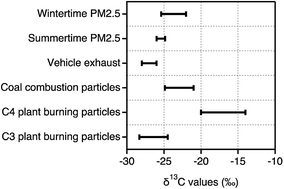Implications for biomass/coal combustion emissions and secondary formation of carbonaceous aerosols in North China†
Abstract
To understand the origins, secondary formation and seasonality of carbonaceous aerosols in North China, we collected PM2.5 samples on day- and night-time bases in summer and winter 2016 from a typical metropolis, Tianjin, and studied their carbonaceous components and stable carbon isotope ratios of total carbon (δ13CTC). PM2.5 ranged from 21.2 μg m−3 to 74.8 μg m−3 in summer and 25.3–816 μg m−3 in winter. On average, organic carbon (OC) elemental carbon (EC) and water-soluble OC were found to be higher (3–5 times) in winter than that in summer. Secondary organic carbon that estimated by EC-tracer method was enhanced by a factor of 7 in winter compared to that in summer. δ13CTC showed a small enrichment of 13C (average −25.41 ± 0.34‰) in summer compared to that (−24.42 ± 0.44‰) in winter. Linear relations and mass ratios of selected carbonaceous components and δ13CTC imply that the carbonaceous aerosols in Tianjin were mainly derived from biomass burning emissions and photochemical processing in summer. In winter, coal combustion emissions and in situ secondary formation of organics, including water-insoluble OC (WIOC), were dominant. This study warrants a need to understand the formation mechanisms of WIOC in the urban atmosphere and thus to reconcile the atmospheric models.



 Please wait while we load your content...
Please wait while we load your content...